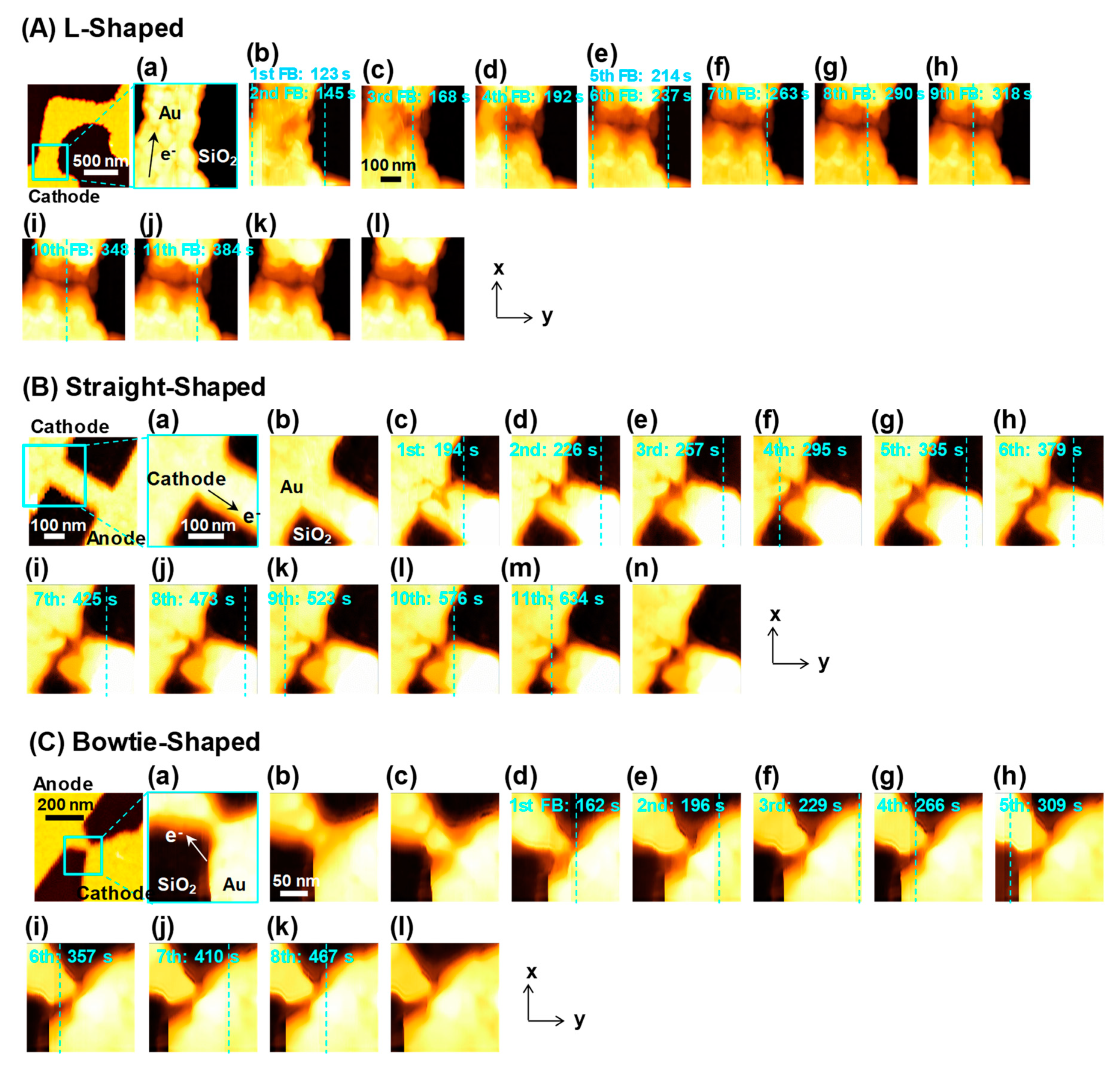Quantifying Joule Heating and Mass Transport in Metal Nanowires during Controlled Electromigration
Abstract
1. Introduction
2. Experimental Method
3. Results and Discussion
3.1. In Situ AFM Imaging of Au Nanowires during FCE
3.2. Mass Transport in Electromigrated Au Nanowires
3.3. Nanoscale Heat Dissipation in Electromigrated Au Nanowires
4. Conclusions
Author Contributions
Conflicts of Interest
References
- Blech, I.A.; Meieran, E.S. Direct transmission electron microscope observation of electrotransport in aluminum thin films. Appl. Phys. Lett. 1967, 11, 263–266. [Google Scholar] [CrossRef]
- Ho, P.S.; Kwok, T. Electromigration in metals. Rep. Prog. Phys. 1989, 52, 301–348. [Google Scholar] [CrossRef]
- Park, H.; Lim, A.K.L.; Alivisatos, A.P.; Park, J.; McEuen, P.L. Fabrication of metallic electrodes with nanometer separation by electromigration. Appl. Phys. Lett. 1999, 75, 301–303. [Google Scholar] [CrossRef]
- Strachan, D.R.; Smith, D.E.; Johnston, D.E.; Park, T.-H.; Therien, M.J.; Bonnell, D.A.; Johnson, A.T. Controlled fabrication of nanogaps in ambient environment for molecular electronics. Appl. Phys. Lett. 2005, 86, 043109. [Google Scholar] [CrossRef]
- Esen, G.; Fuhrer, M.S. Temperature control of electromigration to form gold nanogap junctions. Appl. Phys. Lett. 2005, 87, 263101. [Google Scholar] [CrossRef]
- Hoffmann, R.; Weissenberger, D.; Hawecker, J.; Stöffler, D. Conductance of gold nanojunctions thinned by electromigration. Appl. Phys. Lett. 2008, 93, 043118. [Google Scholar] [CrossRef]
- Xiang, A.; Hou, S.; Liao, J. Tuning the local temperature during feedback controlled electromigration in gold nanowires. Appl. Phys. Lett. 2014, 104, 223113. [Google Scholar] [CrossRef]
- Jeong, W.; Kim, K.; Kim, Y.; Lee, W.; Reddy, P. Characterization of nanoscale temperature fields during electromigration of nanowires. Sci. Rep. 2014, 4, 4975. [Google Scholar] [CrossRef]
- Wu, Z.M.; Steinacher, M.; Huber, R.; Calame, M.; van der Molen, S.J.; Schönenberger, C. Feedback controlled electromigration in four-terminal nanojunctions. Appl. Phys. Lett. 2007, 91, 053118. [Google Scholar] [CrossRef]
- Yagi, M.; Saito, T.; Shirakashi, J. In situ atomic force microscopy imaging of structural changes in metal nanowires during feedback-controlled electromigration. J. Vac. Sci. Technol. B 2015, 33, 051806. [Google Scholar] [CrossRef]
- Bolotin, K.I.; Kuemmeth, F.; Pasupathy, A.N.; Ralph, D.C. Metal-nanoparticle single-electron transistors fabricated using electromigration. Appl. Phys. Lett. 2004, 84, 3154–3156. [Google Scholar] [CrossRef]
- Arzubiaga, L.; Golmar, F.; Llopis, R.; Casanova, F.; Hueso, L.E. In situ electrical characterization of palladium-based single electron transistors made by electromigration technique. AIP Adv. 2014, 4, 117126. [Google Scholar] [CrossRef]
- Liang, W.; Shores, M.P.; Bockrath, M.; Long, J.R.; Park, H. Kondo resonance in a single-molecule transistor. Nature 2002, 417, 725–729. [Google Scholar] [CrossRef] [PubMed]
- Campbell, J.M.; Knobel, R.G. Feedback-controlled electromigration for the fabrication of point contacts. Appl. Phys. Lett. 2013, 102, 023105. [Google Scholar] [CrossRef]
- Durkan, C.; Schneider, M.A.; Welland, M.E. Analysis of failure mechanisms in electrically stressed Au nanowires. J. Appl. Phys. 1999, 86, 1280–1286. [Google Scholar] [CrossRef]
- Popescu, R.; Müller, E.; Wanner, M.; Gerthsen, D.; Schowalter, M.; Rosenauer, A.; Böttcher, A.; Löffler, D.; Weis, P. Increase of the mean inner Coulomb potential in Au clusters induced by surface tension and its implication for electron scattering. Phys. Rev. B 2007, 76, 235411. [Google Scholar] [CrossRef]
- Heersche, H.B.; Lientschnig, G.; O’Neill, K.; van der Zant, H.S.J.; Zandbergen, H.W. In situ imaging of electromigration-induced nanogap formation by transmission electron microscopy. Appl. Phys. Lett. 2007, 91, 072107. [Google Scholar] [CrossRef]
- Stöffler, D.; Fostner, S.; Grütter, P.; Hoffmann-Vogel, R. Scanning probe microscopy imaging of metallic nanocontacts. Phys. Rev. B 2012, 85, 033404. [Google Scholar] [CrossRef]
- Chen, T.Y.; Chien, C.L.; Manno, M.; Wang, L.; Leighton, C. Ballistic heat transport in nanocontacts. Phys. Rev. B 2010, 81, 020301. [Google Scholar] [CrossRef]
- Trouwborst, M.L.; van der Molen, S.J.; van Wees, B.J. The role of Joule heating in the formation of nanogaps by electromigration. J. Appl. Phys. 2006, 99, 114316. [Google Scholar] [CrossRef]
- Taychatanapat, T.; Bolotin, K.I.; Kuemmeth, F.; Ralph, D.C. Imaging electromigration during the formation of break junctions. Nano Lett. 2007, 7, 652–656. [Google Scholar] [CrossRef] [PubMed]
- Haynes, W.M. CRC Handbook of Chemistry and Physics, 90th ed.; CRC Press, Taylor & Francis Group: Boca Raton, FL, USA, 2009; pp. 12–203. [Google Scholar]







| Nanowire | VSTEP (mV) | VFB (mV) | GTH (mS) | ΔMAVE (atoms) | ΔRAVE (atoms/s) |
|---|---|---|---|---|---|
| L-Shaped | 0.8 | 200 | −50 | 2.3 × 107 | 7.6 × 105 |
| Straight-Shaped | 0.5 | 200 | −50 | 2.3 × 106 | 7.7 × 104 |
| Bowtie-Shaped | 0.5 | 200 | −50 | 2.0 × 106 | 6.6 × 104 |
| Nanowire | I (mA) | PC (µW) | VC (V) | TC (K) |
|---|---|---|---|---|
| L-Shaped | 1.84–15.9 | 430–3100 | 0.17–0.28 | 607–935 |
| Straight-Shaped | 3.08–18.2 | 430–1650 | 0.093–0.15 | 420–557 |
| Bowtie-Shaped | 1.63–8.16 | 300–580 | 0.073–0.17 | 379–612 |
© 2019 by the authors. Licensee MDPI, Basel, Switzerland. This article is an open access article distributed under the terms and conditions of the Creative Commons Attribution (CC BY) license (http://creativecommons.org/licenses/by/4.0/).
Share and Cite
Yagi, M.; Shirakashi, J.-i. Quantifying Joule Heating and Mass Transport in Metal Nanowires during Controlled Electromigration. Materials 2019, 12, 310. https://doi.org/10.3390/ma12020310
Yagi M, Shirakashi J-i. Quantifying Joule Heating and Mass Transport in Metal Nanowires during Controlled Electromigration. Materials. 2019; 12(2):310. https://doi.org/10.3390/ma12020310
Chicago/Turabian StyleYagi, Mamiko, and Jun-ichi Shirakashi. 2019. "Quantifying Joule Heating and Mass Transport in Metal Nanowires during Controlled Electromigration" Materials 12, no. 2: 310. https://doi.org/10.3390/ma12020310
APA StyleYagi, M., & Shirakashi, J.-i. (2019). Quantifying Joule Heating and Mass Transport in Metal Nanowires during Controlled Electromigration. Materials, 12(2), 310. https://doi.org/10.3390/ma12020310




